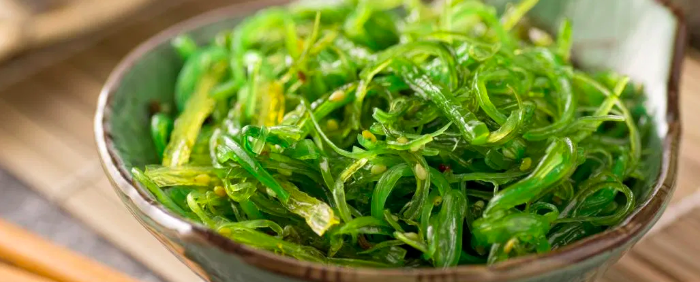
Nutritional value of Nori seaweed
| Dried seaweed (100 g) | |
| Calories | 217 |
| Fat
– Saturated – Monounsaturated – Polyunsaturated |
1.8g
0.4 g 0.2g 0.7 g |
| Cholesterol | 0 mg |
| Protein | 36g |
| Carbohydrates | 23.5g |
| Fibers | 1.9g |
| Sodium | 300 mg |
| Calcium | 436 mg |
| Iron | 11.2 mg |
| Zinc | 6.5 mg |
| Phosphorus | 361 mg |
| Potassium | 2219 mg |
| Food folate / B9 | 912 µg |
| Vitamin C | 243 mg |
| Vitamin A (retinol equivalents) | 1621 µg |
| Beta carotene | 19457 µg |
| Niacin / B3 (equivalent) | 13.6 NS |
Health profile of nori seaweed
Nori seaweed is the second most protein-rich edible seaweed. Vegans include it a lot in their diet, especially since it contains almost all essential amino acids. Nori seaweed is low in fat and contains dietary fiber.
The nori seaweed is rich in minerals including calcium, iodine, potassium, phosphorus, iron and zinc.
It is also a source of vitamin A (especially beta-carotene), complex B (B2, B3, B9) and vitamin C.
Nori seaweed is a naturally salty food. It is therefore necessary to limit as much as possible the addition of salt or the consumption of other foods rich in sodium during the day. Too high a sodium intake can increase the risk of high blood pressure, vascular and heart damage unrelated to blood pressure, has harmful effects on calcium and bone metabolism, increases the risk of gastric cancer as well as the severity of asthma.
Few studies have focused specifically on nori algae. In general, algae are rich in phytonutrients and they are credited with various benefits including arteriosclerosis, high blood pressure, constipation, cancerous tumors, obesity and constipation. Unfortunately, studies have yet to demonstrate these benefits. The main active compound responsible for these benefits would be “sulfated” polysaccharides.
In people with a thyroid function problem, excess iodine may worsen the condition and interfere with treatment. It is therefore important not to consume excess algae. However, be aware that nori seaweed contains little compared to other seaweeds.
Vegans are at higher risk for iodine deficiency because they eat little processed and salty food and they don’t eat fish or dairy products, the two main sources of iodine. Nori leaves are therefore a good alternative.
Use of nori seaweed
For cooking, it is found in dried / dehydrated leaves. It also exists in the form of flakes, granules or powder in health food stores. It is preferable to choose translucent, shiny and brittle sheets. The dried form can be stored in an airtight container in a cool, dry place away from light. It can be kept for almost two years. They must be soaked before consumption or cooking. The time varies between 5 and 60 minutes of soaking.
The nori seaweed is mainly used in sushi maki. As a seasoning or garnish, it is also added to Asian-style soups, pasta or vegetable dishes, salads to enhance its flavor. There are also snacks of dried nori leaves.
Be careful not to add salt to your dishes that contain nori seaweed, as your meal may become too salty.
A word from the nutritionist
Due to its interesting content of vitamins and minerals, the nori seaweed is an ally for vegans and a food to discover in omnivores. Do not hesitate to integrate it other than in sushi and you will be delighted!